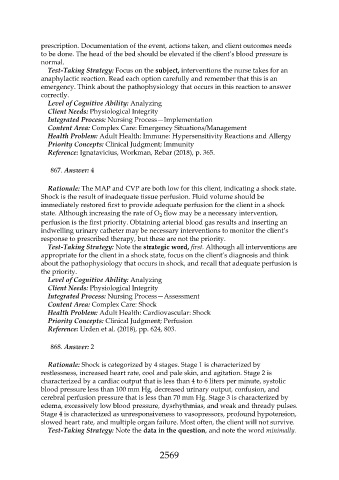Page 2569 - Saunders Comprehensive Review For NCLEX-RN
P. 2569
prescription. Documentation of the event, actions taken, and client outcomes needs
to be done. The head of the bed should be elevated if the client’s blood pressure is
normal.
Test-Taking Strategy: Focus on the subject, interventions the nurse takes for an
anaphylactic reaction. Read each option carefully and remember that this is an
emergency. Think about the pathophysiology that occurs in this reaction to answer
correctly.
Level of Cognitive Ability: Analyzing
Client Needs: Physiological Integrity
Integrated Process: Nursing Process—Implementation
Content Area: Complex Care: Emergency Situations/Management
Health Problem: Adult Health: Immune: Hypersensitivity Reactions and Allergy
Priority Concepts: Clinical Judgment; Immunity
Reference: Ignatavicius, Workman, Rebar (2018), p. 365.
867. Answer: 4
Rationale: The MAP and CVP are both low for this client, indicating a shock state.
Shock is the result of inadequate tissue perfusion. Fluid volume should be
immediately restored first to provide adequate perfusion for the client in a shock
state. Although increasing the rate of O flow may be a necessary intervention,
2
perfusion is the first priority. Obtaining arterial blood gas results and inserting an
indwelling urinary catheter may be necessary interventions to monitor the client’s
response to prescribed therapy, but these are not the priority.
Test-Taking Strategy: Note the strategic word, first. Although all interventions are
appropriate for the client in a shock state, focus on the client’s diagnosis and think
about the pathophysiology that occurs in shock, and recall that adequate perfusion is
the priority.
Level of Cognitive Ability: Analyzing
Client Needs: Physiological Integrity
Integrated Process: Nursing Process—Assessment
Content Area: Complex Care: Shock
Health Problem: Adult Health: Cardiovascular: Shock
Priority Concepts: Clinical Judgment; Perfusion
Reference: Urden et al. (2018), pp. 624, 803.
868. Answer: 2
Rationale: Shock is categorized by 4 stages. Stage 1 is characterized by
restlessness, increased heart rate, cool and pale skin, and agitation. Stage 2 is
characterized by a cardiac output that is less than 4 to 6 liters per minute, systolic
blood pressure less than 100 mm Hg, decreased urinary output, confusion, and
cerebral perfusion pressure that is less than 70 mm Hg. Stage 3 is characterized by
edema, excessively low blood pressure, dysrhythmias, and weak and thready pulses.
Stage 4 is characterized as unresponsiveness to vasopressors, profound hypotension,
slowed heart rate, and multiple organ failure. Most often, the client will not survive.
Test-Taking Strategy: Note the data in the question, and note the word minimally.
2569

